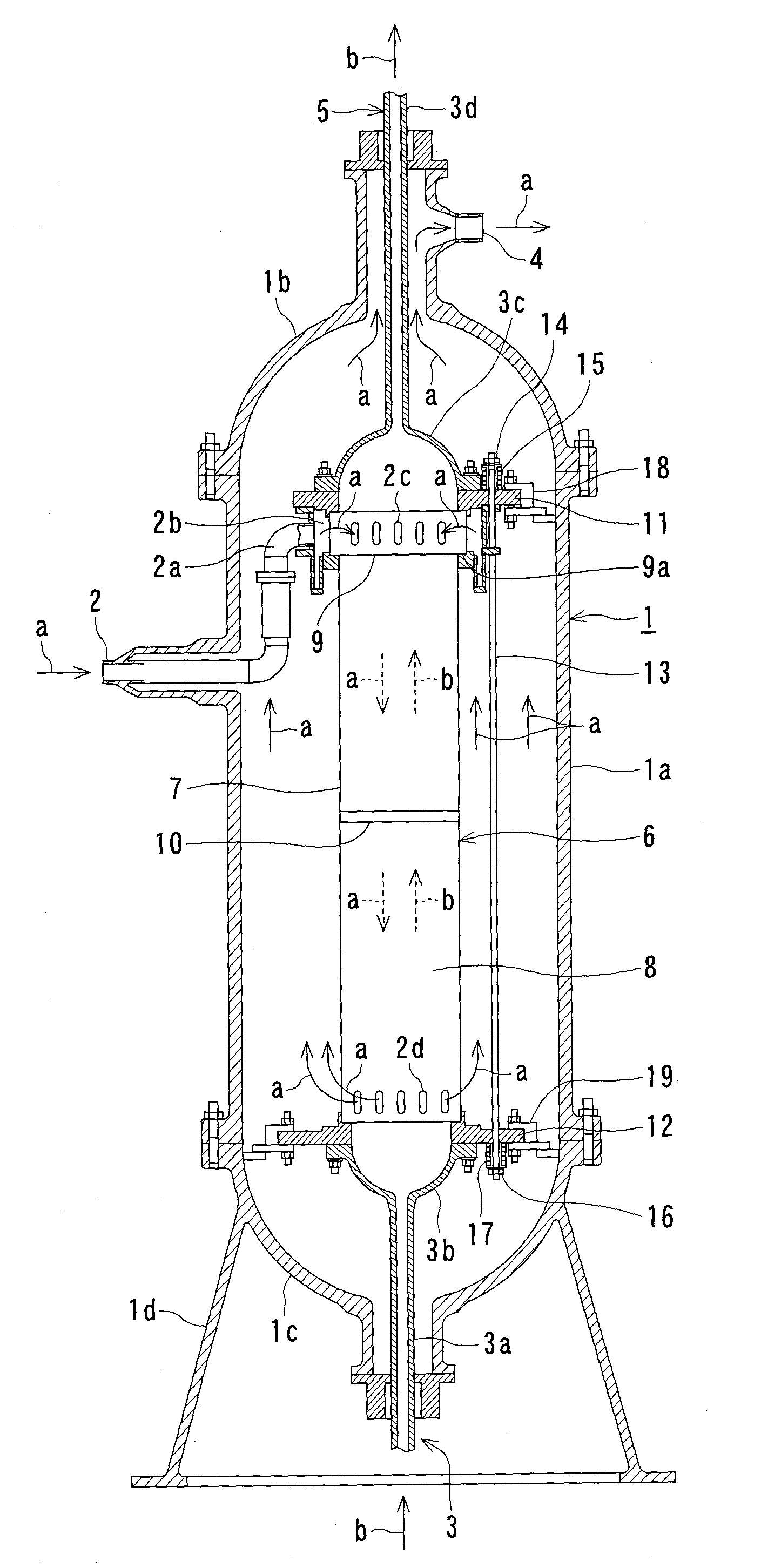Ceramics heat exchanger
- Summary
- Abstract
- Description
- Claims
- Application Information
AI Technical Summary
Benefits of technology
Problems solved by technology
Method used
Image
Examples
first embodiment
FIGS. 1 to 8
[0055]FIG. 1 is a general view of the structure of a ceramic heat exchanger according to a first embodiment of the present invention. The overall structure of the ceramic heat exchanger of a thermochemical IS process hydrogen production apparatus will be described hereunder with reference to FIG. 1.
[0056]As shown in FIG. 1, the ceramic heat exchanger of the present embodiment has a vertically oriented cylindrical pressure vessel 1. The pressure vessel 1 is a gas-tight enclosure including, for example, a barrel 1a and a hemispherical upper mirror portion 1b and lower mirror portion 1c disposed at the top and bottom of the barrel. The lower mirror 1c has a skirt-like support 1d. The support 1d fixes the pressure vessel 1 upright to a predetermined position on an installation floor.
[0057]A helium inlet nozzle 2 through which high-temperature helium gas a, or a first heat exchange fluid, is introduced is provided at an upper position in the wall of the barrel 1a of the press...
second embodiment
FIGS. 1, 9, and 10
[0088]This second embodiment represents a ceramic heat exchanger in which at least one of the ceramic blocks 7 and 8 has tapered portions 30 and 31 at the junction end at which the ceramic blocks 7 and 8 are joined. The tapered portions 30 and 31 have a diameter gradually increases toward the end. The peripheries of the tapered portions 30 and 31 are fitted with tapered rings 32 and 33, respectively. Flanges 36 and 37 having steps 34 and 35 to which the edges of the tapered rings 32 and 33 are seated are provided, and the flanges 36 and 37 are tightened to each other by means of a plurality of tie rods 38. The same parts as in the first embodiment are designated by the same reference numerals and the duplicated description will be omitted herein.
[0089]FIG. 9 is a specific representation of a tightening portion for tightening the ceramic blocks 7 and 8 as an example of the present embodiment.
[0090]In the present embodiment, as shown in FIG. 9, the ceramic blocks 7 a...
third embodiment
FIGS. 1 and 11 to 13
[0101]This third embodiment represents a ceramic heat exchanger having a plurality of ceramic blocks 7 and 8 stacked one on top of the other with a disassemblable seal 10 therebetween. End plates 11 and 12 are disposed outside the stack of the ceramic blocks 7 and 8 and bound with a plurality of tie rods 13 to join and integrate the ceramic blocks 7 and 8. Spacers 40 made of a material in the same series as the tie rods 13 or a material having a higher thermal expansion coefficient than the tie rods 13 are disposed between the end plate 12 and the end portions of the tie rods 13.
[0102]The linear expansion coefficient of ceramic, such as silicon carbide or silicon nitride, is about 4E-6 / ° C. and is lower than that of metals such as stainless steel or inconel. Consequently, the structure of the first or second embodiment in which a plurality of ceramic blocks 7 and 8 are joined and integrated with the seal 10 therebetween produces a thermal expansion difference at ...
PUM
 Login to View More
Login to View More Abstract
Description
Claims
Application Information
 Login to View More
Login to View More - R&D
- Intellectual Property
- Life Sciences
- Materials
- Tech Scout
- Unparalleled Data Quality
- Higher Quality Content
- 60% Fewer Hallucinations
Browse by: Latest US Patents, China's latest patents, Technical Efficacy Thesaurus, Application Domain, Technology Topic, Popular Technical Reports.
© 2025 PatSnap. All rights reserved.Legal|Privacy policy|Modern Slavery Act Transparency Statement|Sitemap|About US| Contact US: help@patsnap.com



